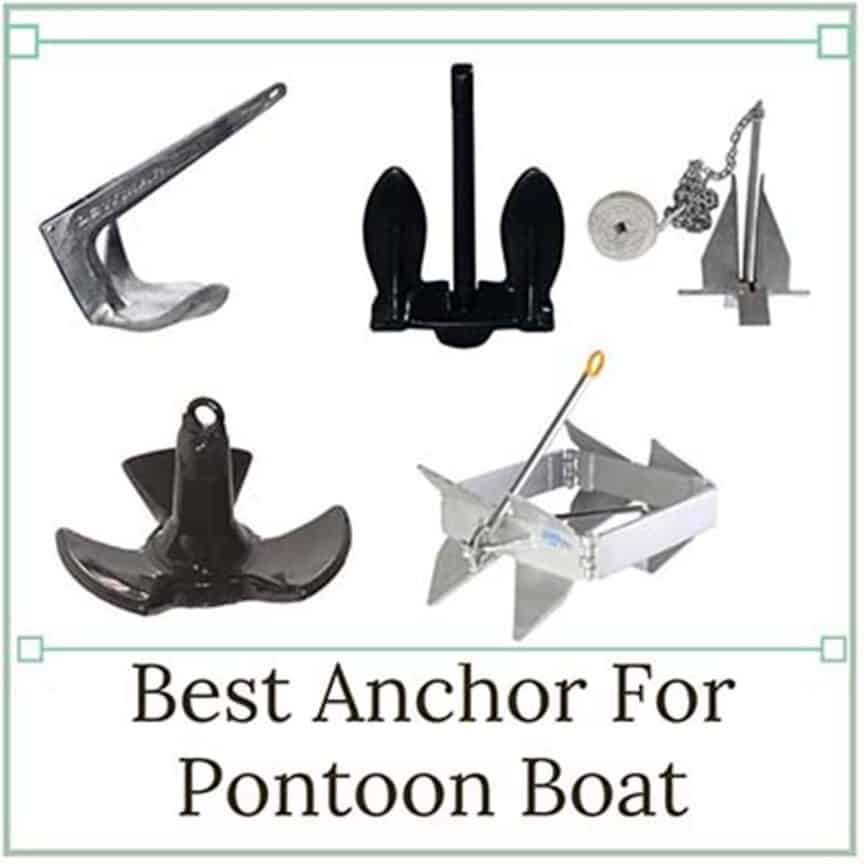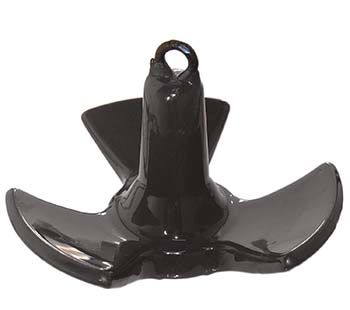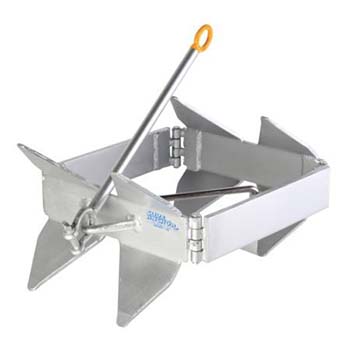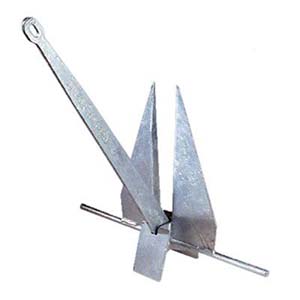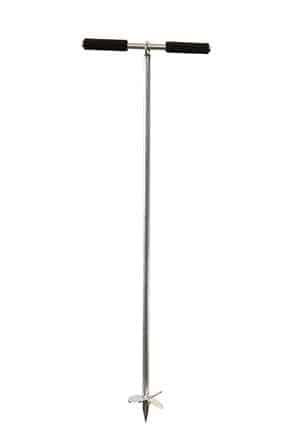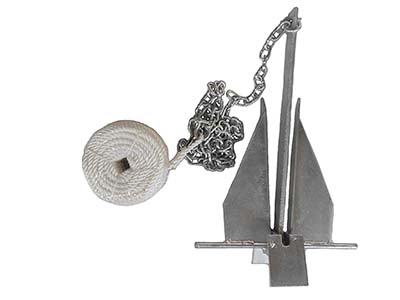One problem that many people have when using their pontoon boats is that their vessels might start to shake around and move in the water even when they don’t want their boats to move. For this problem, the best anchor for pontoon boat is a calming solution. This is frustrating when you are fishing and you are trying to stay in the same position on the water.
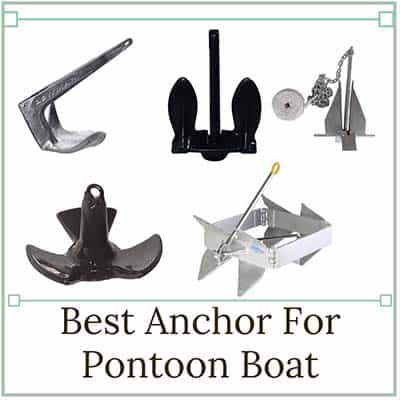
Best Anchor For Pontoon Boat
This is even worse when there is a noticeable current in the water or if wind conditions might get a boat to start moving along gently. But today you have a solution for keeping your pontoon boat in a single spot.
An anchor can be attached to your pontoon boat. This can be lowered down into the water and can secure itself to the bottom of a spot in the water. It is one of the most indispensable materials you could even use in your pontoon boat.
Which Is The Best Anchor For Pontoon Boat? | Comparison Table
| Anchor | Weight (in pounds) | Key Features | View On Amazon |
|---|---|---|---|
| Danielson River PVC Coat Anchor | 12 or 18 | PVC coating | Check Price On Amazon |
| Slide Anchor- Box Anchor | 14/21/26 | Box body folds out automatically when it gets in the water | Check Price On Amazon |
| Lewmar Claw Anchor | 4.4 to 44 | high grade steel, great design | Check Price On Amazon |
| Danforth AMRD-94015.1 Fluke Anchor | 25 | The galvanized body offers a series of sharp points | Check Price On Amazon |
| SandShark Boat or Pontoon Sand Anchor | 4 | Can be inserted near the shore to create a base for your boat | Check Price On Amazon |
| Deluxe Portable 8.5 lb Fluke Style Anchor kit | 8.5 | hot-dip galvanization | Check Price On Amazon |
| SeaSense 74538 Navy Anchor 20Lb Vinyl Coated | 20 lb | vinyl coated, versatile | Check Price On Amazon |
Top Seven Pontoon Boat Anchors Analysed
This listing includes a look at some of the great anchors for pontoon boats that you can use today. These include anchors that will secure themselves well onto the water floor and keep you from moving around when you don’t want to.
Each anchor is different based on its design and weight among other features, so it helps to look at a few special features that make whatever you are offering attractive and valuable.
Our top seven pontoon boat anchors are:
- Danielson River PVC Coat Anchor
- Slide Anchor-Box Anchor
- Lewmar Claw Anchor
- Danforth AMRD-94015.1 Fluke Anchor
- SandShark Boat or Pontoon Sand Anchor
- Deluxe Portable 8.5 lb Fluke Style Anchor kit
- SeaSense 74538 Navy Anchor 20Lb Vinyl Coated
Danielson River PVC Coat Anchor
The steel body of this anchor is appealing enough, but what makes this one of the best anchors for pontoon boat use is that it features a PVC coating. This produces a better amount of coverage that keeps the anchor from wearing out. This adds a smooth surface as well, thus making it easier for the anchor to grab onto the bottom of the water.
This does not have a rope, but it also offers a hole that gives you enough support for adding your own. This is flexible for making it so you can keep it as deep in the water as you might wish.
There are three flukes on this model. These are carefully curved with smooth bodies. This works well for 12 and 18-pound surfaces.
Pros
- Smooth body
- Heavyweight ensures your boat will stay intact
- Easy to apply and use
Cons
- Blades do not appear to be too sharp
- Flukes do not fold inward
Slide Anchor-Box Anchor
Slide Anchor makes this pontoon boat anchor with a distinct shape. You will start using it by linking a rope to the end of the anchor through the yellow hole. After this, you will then throw it into the water.
The stainless steel unit will expand as it is in the water. The pointed flukes will ensure that the anchor will open up quickly and start working. This anchor is available in different sizes (baby, small and large).
When you use the anchor, the unit will be set within a foot of where it lands. This does well regardless of what the weather conditions in a spot might be like. You can quickly retrieve the anchor by pulling on the line.
Pros
- Easy to apply the anchor into the water
- Foldout motion works automatically
- The strong body does not wear out
Cons
- The pointed surface can hurt if you throw it improperly
Lewmar Claw Anchor
This anchor by Lewmar is a versatile anchor that Works on different types of water beds. It can be used for a pontoon boat efficiently. High-grade steel construction and the effective design make it perform so well. Claw/Bruce anchor is great for sandy, muddy, or rocky bottom.
Pros
- High-grade steel last long
- Super design helps to hold strongly almost any bottom
- Easy to set
- Takes minimum time to set
- Can be easily lifted out
Cons
- Struggles with weed bottom
Danforth AMRD-94015.1 Fluke Anchor
Look at this galvanized fluke anchor as the fourth to find as you search for the best anchor for pontoon boat needs. This anchor uses a strong steel body that can handle pontoons up to 40 feet in length. The 25-pound unit features wide flukes with galvanized steel bodies and sharp points.
The shank is also made with the same galvanized coating as the rest of the unit. This adds a strong design that offers a hole for supporting your own rope.
Pros
- Heavy enough to support most common pontoons
- Pointed flukes will not wear out over time
Cons
- The hole for the rope appears to be too small
SandShark Boat Or Pontoon Boat Sand Anchor
This next anchor works a little differently from the ones you have just read about. Sand Shark makes this as a model that you place in shallow water.
What happens here is that you will stick the stainless steel shaft into the water near the shore or in a shallow spot. You place it into the ground and then turn it around a few times to get the base to stick into the surface. Make sure you pat the surface down so that the anchor will stay in its place.
After this, you will add a rope to the top part of the anchor support. This rope should be long enough to bring you out to the spot you want to go to. When you read the end, the rope and anchor will keep you from moving forward.
Pros
- Stainless steel offers a strong body
- Foam handles make it easy for you to grab onto the anchor
Cons
- Needs a strong foundation for it to actually work well enough
Deluxe Portable 8.5 lb Fluke Style Anchor Kit
MarineNow made this useful anchor kit using the hot-dip galvanization method which is great. The anchor weighs 8.5 lbs and can hold small boats.
Fluke anchor works well with mud, sand, or even with the weeds. The height and width of the anchor are 21.5’’ and 15 inches. The included anchor chain and the shackles are also well galvanized.
Pros
- Good for calm conditions
- Works great on soft and medium bottoms even with the weeds
- It comes with an anchor chain (6.5 feet) and shackles
- 98 feet anchor line is included in the kit
Cons
- Not so good for the rocky bottoms
SeaSense 74538 Navy Anchor 20Lb Vinyl Coated
This vinyl-coated cast iron made anchor is a great choice for your pontoon boat. This works with most surfaces. But this is extraordinary with rocky and weedy bottoms.
The anchor is designed to combine the weight and flukes. This combination of this navy anchor makes it penetrate and grip the muddy and sandy waterbed.
Pros
- This navy anchor works with different types of water bottoms
- Easy to use and easy to lift the anchor
- Great for maintaining in one selected spot
- The SeaSense anchor looks gorgeous
Cons
- The anchor is not for the big boats, choose the bigger one for a large boat
Buying Guide
Selecting the appropriate anchor when anchoring a boat is really very important. For primary choice, I give importance to:
a) Type of waterbed
b) Size and weight of the boat & the anchor
c) Type of boat or vessel
d) Possible weather conditions.
To understand the quality I should observe the following points:
Look At the Flukes
The flukes on an anchor will help keep a boat in its place. A fluke is a pointed material that will stick out from the base of the anchor. It can dig into sand or muddy surfaces and keep the anchor from moving.
A good anchor needs flukes that are sturdy enough to keep a hold on a surface while also being able to fold inward when the anchor is not in use. By folding into the center pole, the anchor can be easy to store without you losing control over how it works.
Weight
The weight of your anchor is a vital point to review. An anchor can be a few pounds in weight, but it can also be more than ten pounds if desired.
Look at how well the weight can be applied carefully and that it is even enough. Remember the size and the weight of your boat to select your anchor.
Physical Material
You must look at the physical material being used on the anchor to get an idea of what might work well for you. In most cases, galvanized steel is used for the anchor. This adds enough weight to make it move into the water well enough.
This is also strong enough to handle weather conditions and deep water as it will not rust or corrode. This may be useful for saltwater conditions where untreated metal might be hard to utilize.
Stainless steel is often used just as well. This is a little different in that it offers a better shine and is typically lighter in weight, but it should also handle salt water and most other conditions well enough.
Rope Material
Not all anchors for sale come with their own rope materials. But the ones that do should be reviewed well.
The rope or other material that your anchor is attached to should be sturdy and thick. Nylon and jute materials are often used in the construction of some ropes.
Whatever the case is, the rope must be thick and have a strong weave that will not break apart or tear quickly. Also, the rope’s weave should have small air pockets to where it will allow water to move through without impacting how the rope moves about in the water.
Not all of the best anchors for pontoon boat needs will come with ropes. But many of these models have their own holes that make it easier for you to secure the anchor onto something, which leads to the next point.
Rope Support Hole
The hole used for supporting the rope should be large enough to handle something strong.
It should be enough to handle a thicker rope that will not wear out. Check the size of the hole versus any rope you want to add to it, so you can figure out what is right for you.
Anchoring A Pontoon Boat
Anchoring a pontoon boat is similar to the other types of lake boats or any other boat. Steps should be:
a) Select the right anchor for your pontoon boat
b) Take the best anchor rode
c) Choose a good and suitable position for anchoring. Face and move towards the wind or current very slowly and then drop the anchor slowly and securely until the touching the bottom.
d) Then go back slowly with the current or wind. the right distance will be approximately 6/7 times the water depth of the position.
e) Don’t forget to tie the anchor to a deck cleat.
f) Set and check if the anchor is set or not by a small reverse power of the engine. Pull the anchor line to understand if the anchor is hooked properly.
g) We recommend using two anchors to avoid drifting.
Which is the best position to install an anchor on a pontoon boat?
The anchor should be dropped facing towards the wind or the current and the front of a pontoon boat is preferable. Now, the wind is always changing its direction and speed.
To avoid drifting I usually put another anchor at the aft side of the boat. This second anchor provides some extra security and peace.
Having an under-deck anchor is getting popular in some places which is not a bad idea. But having only one anchor will not prevent from drifting when the wind hits.
Frequently Asked Questions
What does it mean when a rope on an anchor is marine-grade?
The marine-grade rope is capable of being fully submerged in the water without wearing out or coming apart as it moves deep into the water. The rope should do well, but it should also move deep enough to where the anchor chain is placed.
A good rope will be resistant, not too rigid, and should not be weak in water. These ropes are usually made of nylon, polyester, or high-quality fibers which does not absorb too much water.
What types of materials will your anchor get into?
An anchor will more than likely get into sand or mud. The water floor should be soft enough to handle an anchor.
Will salt water conditions cause damages to a rope that an anchor is attached to?
Salt water should not hurt the rope, but you should at least look for something thicker and denser just to be safe.
How far deep can you get your anchor to go into the water?
The great thing about an anchor is that you can get it to go as far into the water as you want. But it might be hard for you to get the anchor to move into the water if you want to put it in a lower position.
How fast should the anchor move while under the water?
You should try to keep the anchor moving by a few feet per second to make it easier for the anchor to penetrate the water floor as you move it down.
How will you get the anchor out of the surface?
You would have to pull on the wire or rope to get the anchor removed. Of course, you would have to keep the motor or any other propulsion features on the boat off so the anchor will not accidentally lift itself out of the surface you have put it in.
Can you sharpen your anchor’s flukes if needed?
You have the option to sharpen the flukes on your anchor if desired, but the key is to keep their shapes intact. You do not want to change the overall appearance of the flukes in any way as they might not work as well if you modify them far too much.
Does the anchor have to be stored somewhere?
You don’t necessarily have to store your anchor in some space when you are not using it, but it does help to at least store it in some kind of bag just to keep it organized.
Conclusion
You must see how well any anchor you plan on using on your pontoon boat is arranged. The best anchor for pontoon boat use is often made to make it easier for a boat to stay intact in the water.
Take a look at how an anchor of value to you is laid out and how you can get it to work in any situation. Remember that there is a wide variety of anchors for you to choose from, but in the end, you will have to figure out a good option yourself to see what can come out of an anchor for your desires.

